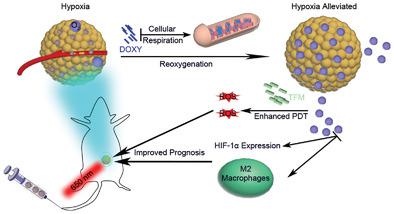当前位置:
X-MOL 学术
›
Part. Part. Syst. Charact.
›
论文详情
Our official English website, www.x-mol.net, welcomes your
feedback! (Note: you will need to create a separate account there.)
Modulating Endogenous Oxygen Consumption Enhanced AIEgens-Mediated Photodynamic Therapy against Advanced Bladder Tumor
Particle & Particle Systems Characterization ( IF 2.7 ) Pub Date : 2021-08-02 , DOI: 10.1002/ppsc.202100048 Jiange Hao 1 , Haoli Yin 1 , Wenfeng Lu 1 , Junlong Zhuang 1 , Mengxia Chen 1 , Jie Gao 1 , Guanchen Zhu 1 , Wenmin Cao 1 , Yansheng Kan 1 , Yingqiang Lu 1, 2 , Hongqian Guo 1
Particle & Particle Systems Characterization ( IF 2.7 ) Pub Date : 2021-08-02 , DOI: 10.1002/ppsc.202100048 Jiange Hao 1 , Haoli Yin 1 , Wenfeng Lu 1 , Junlong Zhuang 1 , Mengxia Chen 1 , Jie Gao 1 , Guanchen Zhu 1 , Wenmin Cao 1 , Yansheng Kan 1 , Yingqiang Lu 1, 2 , Hongqian Guo 1
Affiliation

|
Photodynamic therapy (PDT) plays an important role in tumor therapy. However, PDT outcomes remain poor due to the insufficient reactive oxygen species (ROS) yield of the photosensitizer and the aggravation of hypoxia in the tumor microenvironment through PDT. To solve this issue, a puissant PDT nanoparticles (NPs) platform is developed to defeat tumors by employing powerful PDT in an oxygen-enriched tumor microenvironment and by inhibiting tumor migration through regulating hypoxia-related pathways. Specifically, TFM, as a previously reported AIEgen, does not emit brightly but instead makes use of its nonradiative relaxation for ROS generation, along with oxygen regulator doxycycline (DOXY), both of which are encapsulated in NPs that can specifically penetrate deep into tumor tissue. After released from the NPs, TFM functions as a powerful ROS generator, and DOXY reduces endogenous oxygen consumption via regulating mitochondrial cytochrome oxidase 1, further enhancing TFM-mediated PDT efficacy. Meanwhile, reoxygenation is observed to reduce the expression of hypoxia inducible factor-1α and M2 macrophages induced by PDT. The amplified PDT not only strongly killed tumor but, along with the downregulated hypoxia related pathways during the post-PDT process, inhibited tumor migration. In summary, such NPs exhibit potent anti-tumor effects for advanced bladder cancer therapy.
中文翻译:

调节内源性氧消耗增强 AIEgens 介导的针对晚期膀胱肿瘤的光动力疗法
光动力疗法(PDT)在肿瘤治疗中发挥着重要作用。然而,由于光敏剂的活性氧 (ROS) 产量不足以及通过 PDT 加剧肿瘤微环境中的缺氧,PDT 结果仍然很差。为了解决这个问题,开发了一种强大的 PDT 纳米粒子 (NPs) 平台,通过在富氧肿瘤微环境中使用强大的 PDT 并通过调节缺氧相关途径抑制肿瘤迁移来击败肿瘤。具体来说,作为先前报道的 AIEgen,TFM 不会发出明亮的光,而是利用其非辐射弛豫产生 ROS,以及氧调节剂多西环素 (DOXY),两者都封装在 NPs 中,可以专门深入肿瘤组织. 从 NP 释放后,TFM 作为强大的 ROS 发生器发挥作用,而 DOXY 通过调节线粒体细胞色素氧化酶 1 减少内源性耗氧量,进一步增强 TFM 介导的 PDT 功效。同时,观察到复氧降低了 PDT 诱导的缺氧诱导因子-1α 和 M2 巨噬细胞的表达。放大的 PDT 不仅能强烈杀死肿瘤,而且在 PDT 后过程中下调缺氧相关通路,抑制肿瘤迁移。总之,这些纳米颗粒对晚期膀胱癌治疗表现出强大的抗肿瘤作用。放大的 PDT 不仅能强烈杀死肿瘤,而且在 PDT 后过程中下调缺氧相关通路,抑制肿瘤迁移。总之,这些纳米颗粒对晚期膀胱癌治疗表现出有效的抗肿瘤作用。放大的 PDT 不仅能强烈杀死肿瘤,而且在 PDT 后过程中下调缺氧相关通路,抑制肿瘤迁移。总之,这些纳米颗粒对晚期膀胱癌治疗表现出强大的抗肿瘤作用。
更新日期:2021-09-16
中文翻译:

调节内源性氧消耗增强 AIEgens 介导的针对晚期膀胱肿瘤的光动力疗法
光动力疗法(PDT)在肿瘤治疗中发挥着重要作用。然而,由于光敏剂的活性氧 (ROS) 产量不足以及通过 PDT 加剧肿瘤微环境中的缺氧,PDT 结果仍然很差。为了解决这个问题,开发了一种强大的 PDT 纳米粒子 (NPs) 平台,通过在富氧肿瘤微环境中使用强大的 PDT 并通过调节缺氧相关途径抑制肿瘤迁移来击败肿瘤。具体来说,作为先前报道的 AIEgen,TFM 不会发出明亮的光,而是利用其非辐射弛豫产生 ROS,以及氧调节剂多西环素 (DOXY),两者都封装在 NPs 中,可以专门深入肿瘤组织. 从 NP 释放后,TFM 作为强大的 ROS 发生器发挥作用,而 DOXY 通过调节线粒体细胞色素氧化酶 1 减少内源性耗氧量,进一步增强 TFM 介导的 PDT 功效。同时,观察到复氧降低了 PDT 诱导的缺氧诱导因子-1α 和 M2 巨噬细胞的表达。放大的 PDT 不仅能强烈杀死肿瘤,而且在 PDT 后过程中下调缺氧相关通路,抑制肿瘤迁移。总之,这些纳米颗粒对晚期膀胱癌治疗表现出强大的抗肿瘤作用。放大的 PDT 不仅能强烈杀死肿瘤,而且在 PDT 后过程中下调缺氧相关通路,抑制肿瘤迁移。总之,这些纳米颗粒对晚期膀胱癌治疗表现出有效的抗肿瘤作用。放大的 PDT 不仅能强烈杀死肿瘤,而且在 PDT 后过程中下调缺氧相关通路,抑制肿瘤迁移。总之,这些纳米颗粒对晚期膀胱癌治疗表现出强大的抗肿瘤作用。











































 京公网安备 11010802027423号
京公网安备 11010802027423号